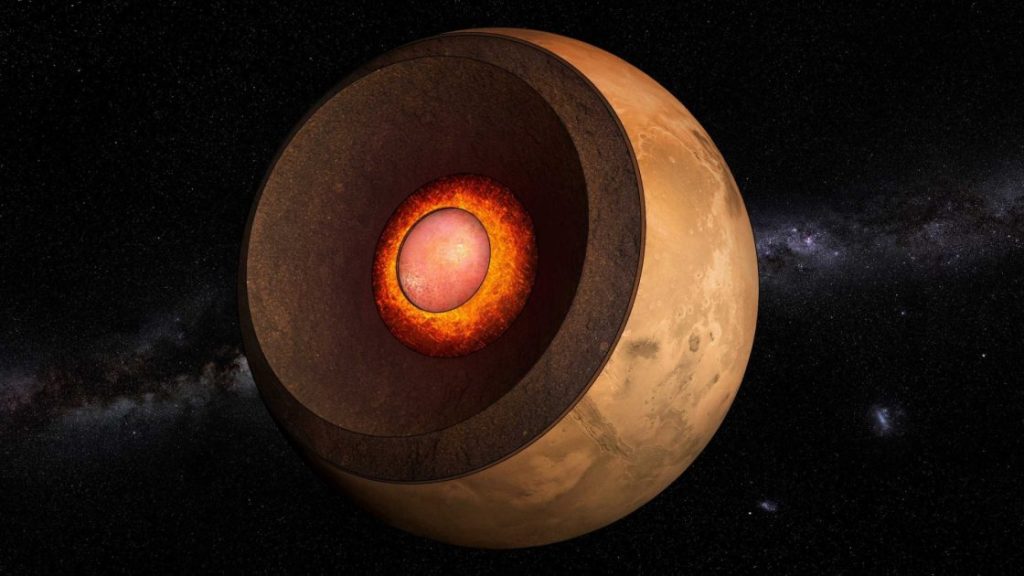Mars’ liquid iron core is smaller and denser than previously thought
A set of seismic data collected by NASA’s InSight lander has provided us a unique glimpse into the interior structure of Mars. What researchers from ETH Zurich have found challenges existing models of the red planet’s inner system, not only by shrinking Mars’s liquid iron core but also by showcasing a hidden layer of molten rock encasing it.
“Although the mission ended in December 2022, we’ve now discovered something very interesting,” Amir Khan, a Senior Scientist in the Department of Earth Sciences at ETH Zurich, said.
Indeed, the findings are nothing short of fascinating. Mars’ geology, including its volcanism and tectonics, is influenced by its internal structure. A smaller core may have implications for the planet’s geological processes, which are important for studying the planet’s surface features and understanding potential habitability conditions in the past or present.
Traditionally, our understanding of Mars was based on the assumption that its core resembled a uniform sphere of liquid iron. However, these new observations, backed by computer simulations, introduce a layer of liquid silicate, or magma, approximately 150 kilometers thick between Mars’s solid silicate mantle and its liquid iron alloy core. This is a phenomenon not observed on Earth, challenging our assumptions about planetary interiors.

Initial estimates of Mars’ core density suggested a surprisingly high proportion of light elements compared to Earth. While Earth’s core consists of about 90 percent iron by weight, Mars’s core was believed to have around 20 percent light elements. This difference had puzzled scientists for years.
However, the new data has clarified the situation. The researchers have determined that Mars’s core is smaller than previously assumed (1,800–1,850 kilometers), with a radius now estimated to fall between 1,650 and 1,700 kilometers, about 50 percent of Mars’s overall radius. This smaller core, with the same mass, leads to increased density and a reduced percentage of light elements. The red planet’s smaller core can help scientists refine their theories about how Mars formed and evolved over time, including processes like mantle convection and magnetic field generation.
According to Paolo Sossi, an Assistant Professor in the Department of Earth Sciences at ETH Zurich, this new composition “is no longer inexplicable in the context of typical planet formation scenarios.” This suggests that Mars’s core formed early in the solar system’s history when lighter elements were more abundant in the surrounding nebula gas.
The initial calculations were primarily based on seismic data collected in the vicinity of the InSight lander. However, two quakes on the opposite side of Mars, including one caused by a meteorite impact, provided seismic waves that traversed the core.
These quakes, as Cecilia Duran, a doctoral student in the Department of Earth Sciences at ETH Zurich, explains, produced seismic waves that traversed the core.
“This allowed us to illuminate the core,” added Duran.
To determine the composition of the core, the researchers turned to a unique approach. They used supercomputer simulations to compute the properties of various alloys of iron containing different proportions of light elements (such as sulfur, carbon, oxygen, and hydrogen). These calculations were then compared to measurements based on the InSight seismic data. Surprisingly, they found that the region thought to be the outer liquid iron core was, in fact, the deepest part of the mantle.
“InSight was a very successful mission that provided us with a lot of new data and insights,” Khan said.
Mars’ core composition and size are key factors influencing its magnetic field, with a smaller, denser core potentially causing the loss of the magnetic field and impacting its historical atmospheric and surface conditions.
About NASA’s InSight Mission
NASA’s InSight (Interior Exploration using Seismic Investigations, Geodesy, and Heat Transport) mission, a robotic lander on Mars, aims to study the planet’s interior by detecting Marsquakes with seismometers, measuring heat flow using the HP3 instrument, and precisely gauging Mars’s rotation to understand core size and composition, all with the goal of creating a comprehensive understanding of Mars’s internal structure and geological history, ultimately enhancing our grasp of planetary formation and evolution.
Auto Amazon Links: No products found.


